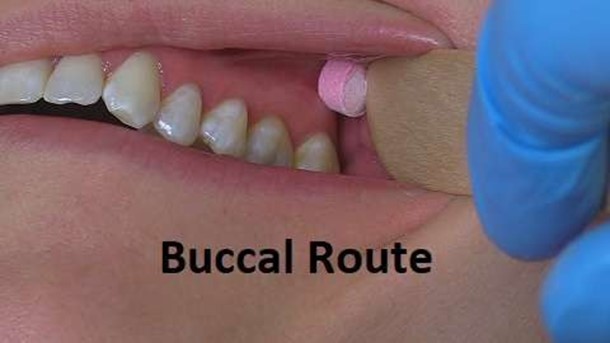A nurse is caring for a client who is receiving hospice care and has a prescription for fentanyl buccal film.
Which of the following methods should the nurse use to administer this medication?
Place the medication on the client's tongue for dissolution.
Dissolve the medication in water before administering it.
Insert the medication against the mucous membrane of the cheek.
Instruct the client to swallow the medication with a sip of water.
The Correct Answer is C

Fentanyl buccal film is a small film that sticks to the inside of the cheek and eventually dissolves within 15 to 30 minutes after it is applied.
It is used to manage breakthrough pain in patients with cancer who are already using another opioid pain medicine around-the-clock.
Choice A is wrong because the medication should not be placed on the client’s tongue for dissolution.
Choice B is wrong because the medication should not be dissolved in water before administering it.
Choice D is wrong because the client should not be instructed to swallow the medication with a sip of water.
Nursing Test Bank
Naxlex Comprehensive Predictor Exams
Related Questions
Correct Answer is C
Explanation
The correct answer is Choice C.
Choice A rationale:
- This response is not appropriate because it is judgmental and may make the client feel defensive.
- It is important for the nurse to respect the client's right to make their own decisions about their health care.
- Telling the client what they should do can undermine their autonomy and potentially damage the nurse-client relationship.
- It's crucial for the nurse to remain objective and avoid imposing their personal opinions or beliefs onto the client.
Choice B rationale:
- This response is also not appropriate because it is using scare tactics to try to persuade the client to get the vaccine.
- This approach can be counterproductive and may further alienate the client.
- It's important to provide accurate information about the risks and benefits of the vaccine in a neutral and non-threatening manner.
Choice C rationale:
- This is the most appropriate response because it acknowledges the client's right to refuse the vaccine while still encouraging them to get it.
- It also demonstrates respect for the client's autonomy and validates their feelings.
- This approach is more likely to foster a positive nurse-client relationship and keep the door open for future discussions about vaccination.
Choice D rationale:
- This response is not accurate because the influenza vaccine is not mandatory for all clients before discharge.
- It is important for the nurse to provide accurate information to the client.
- Threatening the client with an against medical advice form is not appropriate and may be considered a form of coercion.
Correct Answer is A
Explanation
Discard the vial of medication if the solution is cloudy.
This is because epoetin alfa should not be used if it has been frozen or if it has changed color or has particles in it.
Choice B is wrong because the vial should not be shaken before use.
Choice C is wrong because epoetin alfa should not be diluted with sterile water or any other liquid.
Choice D is wrong because epoetin alfa should not be frozen and therefore does not need to be thawed before administration.
Whether you are a student looking to ace your exams or a practicing nurse seeking to enhance your expertise , our nursing education contents will empower you with the confidence and competence to make a difference in the lives of patients and become a respected leader in the healthcare field.
Visit Naxlex, invest in your future and unlock endless possibilities with our unparalleled nursing education contents today
Report Wrong Answer on the Current Question
Do you disagree with the answer? If yes, what is your expected answer? Explain.
Kindly be descriptive with the issue you are facing.
